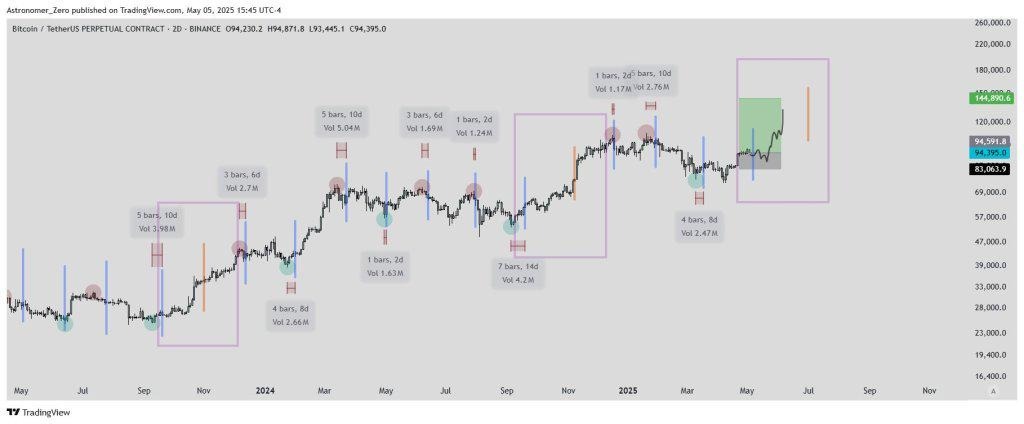As the Federal Open Market Committee prepares to unveil its policy decision on May 7, Bitcoin traders encounter a pivotal moment influenced by macroeconomic factors that may shape price movements through the summer months. The Federal Reserve, led by Chair Jerome Powell, is highly likely to maintain the fed-funds corridor at 4.25 to 4.50 percent; the CME Group’s FedWatch tool indicates a 98.2 percent probability of no change in policy. That near-certainty, however, has not silenced the political discourse.
President Donald Trump and Treasury Secretary Scott Bessent have publicly advocated for reduced borrowing costs; however, Powell’s latest comments on 16 April positioned monetary policy in a “wait-and-see mode.” He noted that the labor market “is in decent shape” but emphasized the Fed’s “obligation is to keep longer-term inflation expectations well anchored and to ensure that a one-time increase in the price level does not evolve into a persistent inflation issue.” The central bank remains focused on maintaining price stability, despite leading indicators suggesting a deceleration in economic activity and a probable shift towards easing measures in the latter half of the year.
The discussion surrounding Bitcoin centers not on the immediate actions of the Fed but rather on the responses of algorithmic liquidity and discretionary positioning to the nuances of Powell’s press conference. Crypto trader Josh Rager informed his followers on X, “Expect chop chop until FOMC tomorrow.” Subsequent to the announcement of the rate cut, one should anticipate increased volatility. Following a reversal during Powell’s address. That represents my current strategy regarding the FOMC. While Rager’s baseline anticipates a future decrease in rates, his immediate attention is directed towards the intraday volatility that usually characterizes the statement-and-Q&A period.
Astronomer (@astronomer_zero) presented a more probabilistic roadmap, highlighting that his trademarked FOMC‑reversal model has “consistently provided reversals with an over 85 percent chance.” If the mechanics persist this month, it would indicate that we have reached a peak either this week or last week prior to a substantial decline.
He moderates that historical perspective by acknowledging that the current quarterly uptrend in Bitcoin may obscure the signal: “That would mean that this and/or next FOMC meeting both have a weakened reversal effect in the midst of what I expect to be a strong uptrend.”
Analysis of Bitcoin in relation to the FOMC
In practical terms, he anticipates: “I think the most likely scenario (76% chance) is a move up from here and the FOMC reversal gets completely ignored.” The lesser probability (24%) represents a relatively modest retracement within our stop-loss range.
Columbus (@columbus0x) examines the microstructure for validation. Referencing a Hyblock heat-map of liquidations, he anticipates “a wick below into the box… below the equal lows and also exactly the area that Hyblock has highlighted as a yellow zone,” a region that aligns with the 0.382 Fibonacci retracement from the last significant swing low.
Should Powell adopt a hawkish stance, Columbus predicts “a deviation below the range low / a retest of the 200‑day SMA, closing the CME gap between $91.8 and $92.4 k – or potentially even falling into the high $80’s.” Nonetheless, the trend is upward.
Momentum diagnostics provide an additional layer of analysis. Titan of Crypto notes that Bitcoin “is consolidating between last week’s high and low, awaiting tomorrow’s FOMC meeting and Jerome Powell’s speech.” Meanwhile, the daily MACD is exhibiting a bearish crossover, indicating a deceleration in momentum.” A confirmed rollover in the histogram would align with the shallow-pullback scenario outlined by Astronomer and Columbus; however, the consolidation itself maintains a constructive outlook for higher-time-frame trend traders.
When considered collectively, the decision expected tomorrow seems to present a binary choice at first glance; however, the true factor at play is Powell’s forward-guidance language and its influence on terminal-rate pricing. Should the Chair emphasize the need for patience while recognizing the softer data, the curve may start to factor in a potential cut in June, thereby offering a macroeconomic advantage that supports the bulls’ quarterly argument.
Conversely, any indication of renewed vigilance regarding inflation would strengthen the resolve of short-term bears seeking liquidity beneath $92 k. Regardless, the market exhibits minimal tolerance for complacency: liquidity remains sparse, options gamma is concentrated around the psychologically significant $100,000 strike, and the prevailing narrative regarding a potential easing cycle in the latter half of 2025 is directly conflicting with the Federal Reserve’s immediate inflation objectives.

